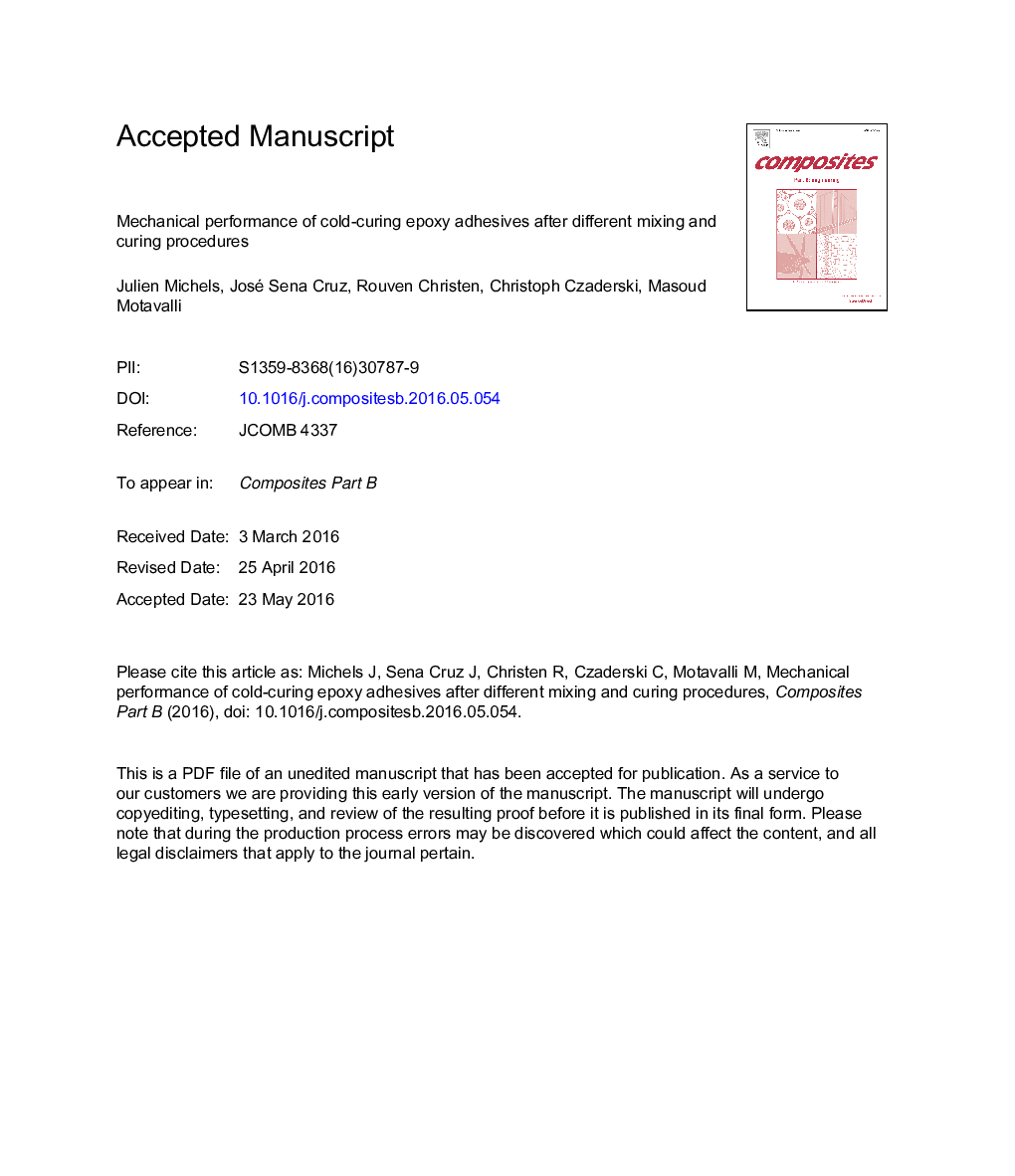| کد مقاله | کد نشریه | سال انتشار | مقاله انگلیسی | نسخه تمام متن |
|---|---|---|---|---|
| 7212586 | 1469387 | 2016 | 36 صفحه PDF | دانلود رایگان |
عنوان انگلیسی مقاله ISI
Mechanical performance of cold-curing epoxy adhesives after different mixing and curing procedures
ترجمه فارسی عنوان
عملکرد مکانیکی چسب اپوکسی سرپوش پس از روش های مختلف مخلوط کردن و پخت
دانلود مقاله + سفارش ترجمه
دانلود مقاله ISI انگلیسی
رایگان برای ایرانیان
کلمات کلیدی
رزین های حرارتی، استحکام، قطر بینی، تست مکانیکی،
ترجمه چکیده
در این مقاله، مشخصه های قدرت، سختی و تخلخل چسب اپوکسی سرماخوردگی در دسترس برای کاربردهای مهندسی سازه در زمینه اتصالات خارجی و / یا نصب شده در سطح کامپوزیتی سطحی، ارائه شده است. بسته به شرایط خاص، شستشوی سریع چسب در دمای بالا ممکن است ضروری باشد. تحقیقات تجربی با هدف ارزیابی اختلافات احتمالی مقاومت و سختی بین نمونه هایی که در دمای بالا برای مدت زمان تعریف شده و در دمای اتاق درمان می شوند. می توان ثابت کرد که برای یک دوره نمونه های مشابه، استحکام کششی اسمی و سختی پس از یک فرآیند پخت اولیه شتاب در دمای بالا، پایین تر است. علاوه بر این، می توان نشان داد که نمونه ها پس از یک شستشوی سریع در دمای بالا، تخلخل افزایش یافته است. توسعه یک کد عددی برای تحلیل تصویر، امکان بررسی دقیق چندین سطح شکستگی را فراهم کرد و سپس به منظور کاهش سطح مقطع در دسترس به علت افزایش تخلخل کلی، بررسی شد. زیان های ناحیه مقطعی در محدوده 10 تا 15 درصد نسبت به نمونه های مرجع می تواند محاسبه شود. مشتق بعد از استحکام کششی واقعی، تفاوت های کوچکتری را بین اتاق و نمونه های تحت تابش با دمای بالا نشان می دهد. صرف نظر از قدرت مضاعف کوتاه مدت، تخلخل مشاهده شده می تواند مسائل مربوط به دوام مهم در یک درازمدت و مورد نیاز باشد.
موضوعات مرتبط
مهندسی و علوم پایه
سایر رشته های مهندسی
مهندسی (عمومی)
چکیده انگلیسی
This paper presents strength, stiffness, and porosity characteristics of commercially available cold-curing epoxy adhesives for structural engineering applications in the field of externally bonded and/or near-surface mounted composite strip reinforcements. Depending on specific requirements, accelerated curing of the adhesive under high temperatures might be necessary. Experimental investigations aimed at assessing the possible differences in strength and stiffness between samples cured at elevated temperatures for a defined time span and the ones cured at room temperature. It could be demonstrated that for the same specimen age, nominal tensile strength and stiffness are lower after an initial accelerated curing process at elevated temperatures. Furthermore, it could be shown that the specimens after an accelerated curing at elevated temperatures exhibited an increased porosity. The development of a numerical code for image analysis allowed a detailed inspection of several fracture surfaces and subsequently to assess the level of decrease in available cross-section due to an increased overall porosity. Cross-section area losses in the range of 10-15% compared to the reference specimens could be deduced. The subsequent derivation of the actual tensile strength exhibits smaller differences between the room and high temperature exposed specimens while curing. Regardless of the short-term material strength, the observed porosity might be subject of important durability issues on a long-term and needs further investigation.
ناشر
Database: Elsevier - ScienceDirect (ساینس دایرکت)
Journal: Composites Part B: Engineering - Volume 98, 1 August 2016, Pages 434-443
Journal: Composites Part B: Engineering - Volume 98, 1 August 2016, Pages 434-443
نویسندگان
Julien Michels, José Sena Cruz, Rouven Christen, Christoph Czaderski, Masoud Motavalli,
